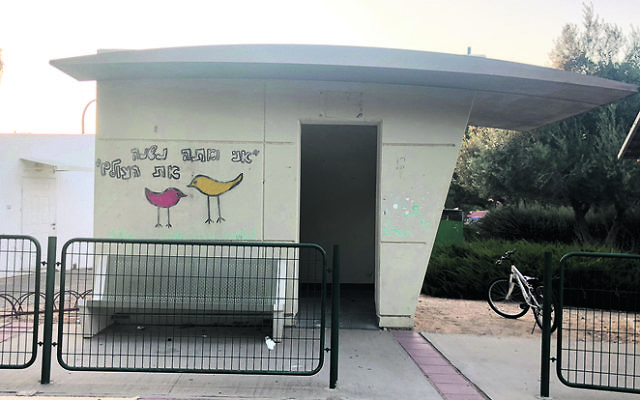Living on the border in the shadow of terror
"One thing is for sure, as long as that bomb shelter still has a purpose, that change we want to see in the world will sadly never come." Emily Gian shares her experience of visiting a bomb shelter on Kibbutz Erez, situated very close to the Gaza border.
YOU and I
“We’ll change the world.”
This is not the first time I have taken a picture of these words but this moment certainly felt the most poignant.
You see, these are lyrics to a song written by the late, great Arik Einstein and they are painted on the outside walls of a bomb shelter on Kibbutz Erez, which happens to be situated less than three kilometres away from Israel’s border with Gaza.
The irony is that if a rocket was fired from Gaza, the citizens of Kibbutz Erez would not even have time to get to that shelter – they live so close to the border that they do not even have the 15 seconds we often hear about when people speak about the communities of Israel’s south.
I spent a recent weekend at Kibbutz Erez with my family, visiting my husband’s best friend from the army, his wife and their children. They have lived there for six years, after moving from the centre in Israel in order to strengthen communities on the periphery. The kibbutz is certainly an idyllic place to raise children. No visit there is complete without a look at the dairy cows, a swim in the pool or a walk through the surrounding fields.
Idyllic … except for the fact that there are homicidal terrorists residing just three kilometres away who are constantly planning new ways to terrorise the residents – be it via rockets, tunnels, or the latest form of terrorism – incendiary devices attached to balloons and kites, sent over the border and wreaking havoc on the local environment. Thousands of acres of fields, farms and nature reserves, wildlife and farm animals from turkeys and bees in this region have been wiped out by the so-called “peace demonstrators” from Gaza with (to their shame) barely a whimper from environmentalists around the world.
A number of those balloons and kites have set fire to the fields surrounding Kibbutz Erez (though thankfully none have landed within the kibbutz itself). My friend told me of a colourful balloon that landed nearby. It wasn’t burning but had a child playfully touched it, the balloon would have exploded in the child’s face (the IDF found something similar nearby at the same time we were playing with the kids on the swings and slides of the kibbutz). This is not the gift one usually gets from a friendly neighbour.
The family’s two young daughters sleep in the room that doubles as a bomb shelter. It just worked out that way, but turned out to be very convenient a month or two back when Palestinian terrorists fired 200 rockets one evening. And our biggest worry in Australia is how the late light of daylight saving might affect our children’s sleep.
And so, every visit to Kibbutz Erez, on the way back from looking at the cows as they graze just next to a vintage tractor from the early days of the state, I pass this bomb shelter and think about whoever it was that decided to paint on it the words to the popular song –
“You and I
“We’ll change the world.”
You and I meaning the youth of the kibbutz?
You and I meaning the members of the kibbutz and those visiting the area?
Or you and I, meaning Israelis and the next generation of Palestinians?
Were they hopeful when they wrote it?
One thing is for sure, as long as that bomb shelter still has a purpose, that change we want to see in the world will sadly never come.
Emily Gian is media and advocacy director at the Zionist Federation of Australia.


comments